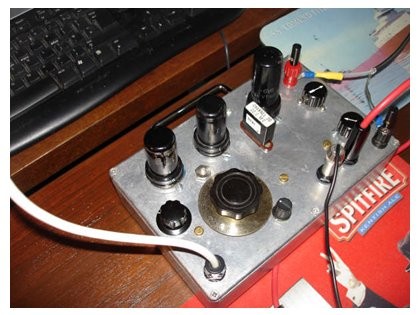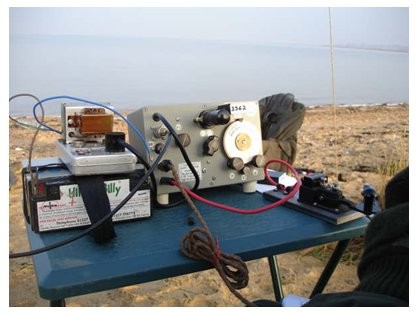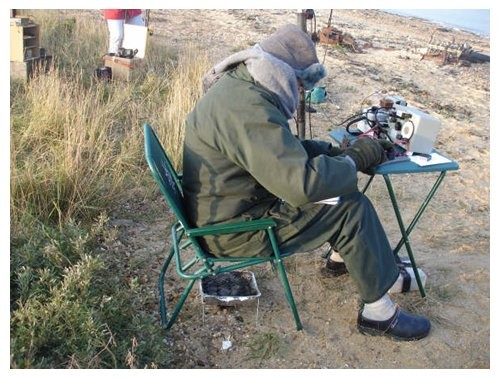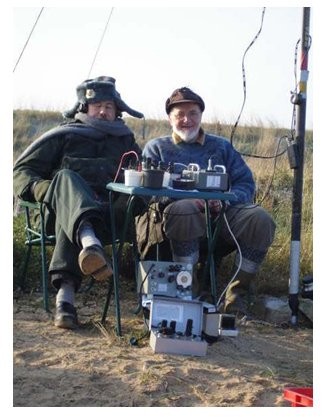Beach
Monday is usually a good day. I tend
to arise early, check the bands and then the emails then after breakfast
I head off to the 'Outlet' shopping centre in the middle of Chatham for lunch
with the other retired local radio amateurs. Lately the bus pass has made
this a cheaper episode with a tour of the North Kent villages thrown in.
It's usually a nice break at the 'Boomer'
Australian café with plenty of conversation over coffee and a Marmite
baguette talking about, well anything really. Charles G4VSZ tells us about
his latest signalling problem on his 'G' gauge garden railway, John G6SXC
relates to us his latest VLF receiver progress for tracking thunder storms,
Brian G0LJD discusses his latest PSK31 exploits whilst Geoff G3YVF and I
talk about CW and our long term interest in portable operating and..TRF
receivers.
Ever since I was at school and built
my first TRF receivers, 'bloopers' to the US readers, I've been fascinated
at how you can get something for nothing in a simple receiver. There is plenty
of gain, they are very sensitive, and although selectivity can be a bit of
a washout - what fun to use. Having played with both direct conversion and
regenerative receivers I would take the TRF any day.
One day Geoff came into the café,
sat down and announced, 'I have a new project'. Our eyes swivelled towards
him in unison. 'Another one?' we responded in chorus. Geoff is a prolific
constructor and 'new projects' are a monthly occurrence. 'Yes' he replied,
'I've designed a single valve transceiver'. I shrank back in horror. I mean
I've used a single 6V6 crystal oscillator in a simple TX many years ago and
I once remember calling W3LPL in the 80m ARRL DX contest with a 6L6 crystal
oscillator even more years ago, (I got 599!), but a receiver with the same
valve? Geoff confirmed it would work and, in typical YVF style, he had the
first version completed by Wednesday with a flight test on Saturday with
his sights set for the forthcoming Minimal Art QRP Contest due in the following
week.
To cut a long story short - it worked.
He used a six pole switch to change the grid, plate, screen, cathode, antenna
and receiver tuning connections on the 6V6 and the finished box had a black
metal 6V6 sticking out of the front. The whole thing was powered by an inverter
from a 12 volt supply and gave a thundering three watts output. 'You can
operate this next week in the QRP contest' he said. 'I'm no operator, you're
in FOC - you should be able to use it'. So using three FT243 80m crystals
clustered around 3560 I worked for three hours faster than a one armed wall
paper hanger, netting with an external oscillator, calling CQ, answering
CQ's, fumbling for the right crystal, sending with a straight key and generally
having fun. Who said I don't work contests?
As I recall we came about halfway down
the pack but to work all around Germany with 3 watts from my location near
London with our best DX as Munich with one valve on blow and suck was stunning.
I mean all that way? Munich? The receiver proved better than I had dared
hoped and had gain although luckily the British Army headphones I was wearing
were resonated with a capacitor to give some degree of audio
selectivity.
This got me interested in another project.
Geoff and Charles had made transceivers based on the 'Paraset' espionage
radio of WW2. If you look at Pierre Lorraine's excellent book on Clandestine
Operations he gives the circuit of the Paraset and it has been copied all
around Europe to this day. It's a simple 6V6 crystal oscillator and two 6SK7's
as a receiver. Sure it's TRF but as it was intended to work with a strong
control station, running anything from 250 watts to 10Kw according to Pierre's
book, it was sufficient in terms of sensitivity, gain and selectivity and
it was small.
Geoff's Paraset used valves but the internals
had been removed and transistors inserted inside the beautiful metal screens,
(remember those lovely black RCA metal tubes?), but from outside the case
it looked like the real thing even down to the WW2 style control knobs. Chas
had a modified Paraset using valves with a multitude of extra controls and
an RF stage - I decided I wanted one too following the original circuit but
after enjoying the outstanding Ten Tec QSK system for years I decided against
a manual changeover switch choosing a TR switch and in the event I had to
arrange a volume control as I had far too much audio gain. I have quite a
few crystals by the way many of which are supplied by Rutland Crystals
(G3MCK).

G3VTT's version of the Paraset
Working but not complete
The photograph shows my version. It's
not quite completed as there are no markings on the controls and I have still
to do some more development on the audio side with improvements to AF
selectivity, but it works. The TR switch uses a 3pf capacitor from the hot
side of the transmitter pi network to a tap low down on the receiver tuning
coil. There's just the one coil in the receiver front end and RF on transmit,
that thundering three watts, turns off the detector due to charging up of
the input capacitor and high value grid resistor of the detector grid leak.
In fact the values are similar to those used in the old valve TR switches
of the 50's. I also found out that 6SJ7 valves give more gain particularly
the one I have stamped 'US Navy'. Would you American readers like it back
under reverse Lease/Lend?
A pair of diodes, modern but necessary
1N5408's, pulls down the AF pentode screen voltage to mute the audio and
another pair back to back are wired across the headphones to limit audio
crashes at TR changeover.
Over the winter break in January 2009
I took part in the GQRP club Winter Sports event where a number of our FOC
crew mingled and operated with the QRP operators some of whom have quite
slow fists and need encouragement.
I decided with Geoff G3YVF and Brian
G0LJD to operate from our local portable site at Coombe Beach North Kent
about 35 miles east of London on Tuesday 30th of December 2008 and to see
what could be done.
Yes I know we need psychiatric help.
Hilary, my wife, took one look at us loaded with equipment and food on our
sack barrow and said 'the pair of you are bonkers' (which is a quaint colloquial
term English readers will recognise regarding madness). It was cold, very
cold, and as we have done this before in 2005 for the Winter Sports we were
aware that you can easily die in the English winter without correct food,
drink, clothing and a warming fire. After 1500z in December with a sea breeze
coming in it can be quite dangerous on the beach. You could easily die of
hypothermia in the low temperatures in an hour or two.

The single valve transceiver
Battery, inverter, transceiver and
key
As you can see from the photograph I'm
wearing a waxed 'Barbour' jacket and trousers over three layers of clothing
and jeans, thermalite gloves, a genuine Angora Peruvian scarf courtesy of
my son Bob who brought it back as a gift after his last trip, a genuine Russian
fur hat and… a pair of clogs. Cold? - you bet. It was initially calm
then we had freezing winds from beyond the Urals haranguing the island kingdom.
Geoff, due to his metabolism, is always racing about and is always hot hence
limiting his clothing to a few layers and his Canadian fur hat. Either that
or he was born on Mars. Sitting still, despite pounding my US Navy key, I
soon got very cold and my skin stuck to the steel base of the key at one
point.
Using an 80m doublet at 25 feet and a
2:1 balun fed through an Electraft T1 auto atu, (I must have some modern
technology somewhere), we put all three valve transceivers on the air in
sequence. The best DX was Ray GI3PDN with G4BUE as a second QSO. A variety
of other stations were worked including an excellent QRQ contact with David
G4HMC. In total we only worked seven stations on the VTT Paraset including
OP5R (ON6WJ) who was also using his Paraset from near Antwerp. Whilst the
band spread of the Paraset was much smaller than the original, with the tuning
covering 3500 to 3580 KHz and not 3 to 9 MHz, tuning was fairly easy although
you had to ride the regeneration controls and the audio control if fitted.
Luckily the single valver also had a limited tuning range.

Hard at work - yes the BBQ is being used
to warm my seat! Brian G0LJD's legs at rear.
On the culinary front we did manage to
consume a large number of sausage and onion baguettes cooked on an open fire,
a canister of Hilary's patented hot spicy soup, some banana baguettes and
plenty of coffee. That is real coffee by the way. As English gentleman we
have opted to take a cafetiere on our beach trips having decided to drop
the prerequisite of tea. One should never consume instant coffee of
course.
Was it worth it? Of course, Coombe Beach
is always fun. Ask G3XAQ, G3MCK and W4CK all of whom have visited this lovely
spot opposite Canvey Island. Why do we do it? It's the love of fresh air
and a chance to experience radio as it was with simple homemade equipment.
This is the first complete transceiver I've made in over 44 years of Amateur
radio and although contacts were few and far between it was fun.
As we pushed our barrow back to the car
Geoff turned to me and said 'that was a full days work'. 'Quite' I replied.
'Next one in February then?' He shuddered.

Transistorised Paraset on ground, single
valve set above with G3VTT's Paraset on the table.
A freezing G3VTT on left and G3YVF to
the right.
Subsequently on behalf of the Invicta
QRP Club, the G - QRP Club G4DQP Trophy for the 2008/9 Winter Sports
was won by these three frozen individuals!
Article printed by permission of FOC
Magazine 'Focus' Spring 2009.
|